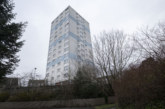Renders and fire safety — more than skin deep, says Lee Lambley, Technical Director at Saint-Gobain Weber.
Ever since the tragedy at Grenfell Tower, fire safety has been an issue of paramount importance at the top of everyone’s mind and attention. Construction product manufacturers have pursued important fire safety initiatives throughout the years and are likely to continue these for many more years yet, driving through a total change in the industry’s attitude to fire and life safety.
Saint-Gobain Weber is no exception. Its renders, decorative finishes and external wall insulation (EWI) products have been tested, retested and reviewed to assess fire safety. Each variation has been put under scientific scrutiny to understand its suitability for multiple building types and scenarios, not just in isolation but also in combinations and building systems commonly found in the UK. Consequently, Weber is entirely confident that its webertherm EWI systems, for example, are appropriate for use across a wide range of building types.
But what do social housing clients and specifiers need to consider when reviewing fire safety claims like this being made today?
Don’t just look for an A2 classification
Our technical experts are warning anyone involved in product specification to look much deeper into claims around fire safety performance.
Most specifiers will be familiar with the British Standard 476 fire test series, which continue to be important tests. But today’s specifications also demand a good understanding of different testing regimes, including the Euroclass classifications, which range from A1 (best) to F (worst). These gradings rely on products passing stringent European (EN) standards which are different from BS 476.
Ever since additional building regulations guidance was issued at the end of 2018, which introduced a ban on the use of combustible materials in the external walls of high-risk residential buildings, there has been a steady presumption that a Euroclass A1 or A2 classification is required for all façade materials.
Or, more precisely, a presumption for dwellings over 18 metres in favour of either A1, which is basically completely non-combustible, or for A2-s1,d0, which describes products that are of limited combustibility and generate very little smoke development and no flaming droplets or particles.
This ‘A1 / A2 approach’ is still considered by many clients and specifiers to design out risk and creates confidence that a building will always comply to future building regulations. However, in some cases, this has led to an over-simplification of the issue.
It’s not enough just to look for an A2 classification. It’s the information that sits behind this grading that matters most, along with a lot of other complementary data.
Interrogate the evidence
The Euroclass test relates to how a product reacts to fire, but there are also essential BS tests regarding fire resistance, which look at integrity and load-bearing capacity, for example.
Most specifiers look at the classification report summary and think “that’s my due diligence done”. But it’s nowhere near that simple. Product decisions should be made based on the full suite of documentation, not just the claims in the marketing literature. This includes looking at the complete set of individual test reports looking at the calorific value of the product, the way it responds to surface spread of flame, and other aspects of performance.
Specifiers should interrogate the evidence for renders and related EWI systems, and insist that all test evidence is made openly available to all customers and published, ideally available on the manufacturer’s website, particularly relating to products used on external façades.
One important check is to ensure that all the documentation matches up. The Euroclass certification for a product should align with the individual test reports. The test reports should align with the Declaration of Performance (DoP).
Another area that needs checking is the date of the test data, as it may be quite old — and chances are, the product may be materially different now from that which was originally tested. Any change to a product’s formulation, no matter how small, means previous test data may be invalid and the product may need to be tested again.
Even colour is a factor
Perhaps surprisingly, one of the key issues in testing renders for fire safety is the colour. Historically manufacturers have only tested lighter colours such as white or cream — not just because these are the most popular colours, but also because the amount of organic (and therefore combustible) content in these renders is less, and so they are more likely to pass a fire test more easily.
An appropriate range of colours should be tested with the support of a UKAS accredited testing facility. Weber has conducted this assessment on its full colour range, including Carnival Red, which contains the highest level of organic content. Greys and yellows can also throw up interesting test results that need careful checking.
The biggest hurdle is becoming better educated and familiar with testing regimes and what different test reports are saying. Once you are familiar with them, it’s not difficult to identify anomalies. So my final advice: keep asking questions and don’t take anything at face value. Any reputable product manufacturer will be happy to share test data openly and honestly.









